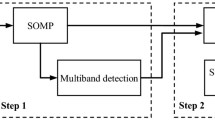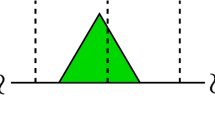Abstract
This paper proposes a joint rapid spectrum scanning and signal feature recognition scheme by using both compressed sensing (CS) and cyclostationary technologies to solve the paradox of rapid spectrum scanning and accurate signal feature recognition. First, a new system architecture for signal feature recognition is designed based on rapid spectrum scanning results to decrease the times of proposed signal feature recognition scheme. Moreover, an improved CS technology is brought forward to accelerate the sensing speed without reconstructing received signals for a rapid spectrum scanning. And a tunable compression gain is proposed to reduce both computation complexity and sampling rate based on the difference of modulation mode and symbol rate for various signals. To further reduce the effect of noise on the modulation classification performance, a novel noise reduction scheme is proposed using the cyclostationary technology. Results prove that proposed scheme can achieve both rapid spectrum scanning and accurate signal feature recognition simultaneously. Furthermore, it can reduce the sampling rate for CS over 30% and achieves a signal detection gain of 2–3 dB with signal to noise ratio constraints.
















Similar content being viewed by others
References
Federal Communications Commission. (Feb. 2005). Notice of proposed rule making and order: Facilitating opportunities for flexible, efficient, and reliable spectrum use employing cognitive radio technologies (pp. 03–108). No: ET Docket.
Stotas, S., & Nallanathan, A. (2011). Enhancing the capacity of spectrum sharing cognitive radio networks. IEEE Transactions on Vehicular Technology, 60(8), 3768–3779.
McHenry, M. A. (2005, August) NSF Spectrum occupancy measurements project summary. Shared spectrum company report.
Chien, Wen-Bin, Yang, Chih-Kai, & Huang, Yuan-Hao. (2010). Energy-saving cooperative spectrum sensing processor for cognitive radio system. IEEE Transactions on Circuits and Systems I: Regular Papers, 58(4), 711–723.
Lin, You-En, Liu, Kun-Hsing, & Hsieh, Hung-Yun. (2012). On using interference-aware spectrum sensing for dynamic spectrum access in cognitive radio networks. IEEE Transactions on Mobile Computing, 12(3), 461–474.
Salt, J. E., & Nguyen, H. H. (2008). Performance prediction for energy detection of unknown signals. IEEE Transactions on Vehicular Technology, 57(6), 3900–3904.
Hauptschein, A., & Knapp, T. (1979). Maximum likelihood energy detection of mary orthogonal signals. IEEE Transactions on Aerospace and Electronic Systems, AES–15(2), 292–299.
Zhao, Y. Q., Li, S. Y., Zhao, N., & Wu, Z. L. (2010). A novel energy detection algorithm for spectrum sensing in cognitive radio. Information Technology Journal, 9(8), 1659–1664.
Eftekhari, A., Romberg, J., & Wakin, M. B. (2013). Matched filtering from limited frequency samples. IEEE Transactions on Information Theory, 59(6), 3475–3496.
Cai, Z. P., Wang, Z. J., & Zheng, K. (2011). A distributed TCAM coprocessor architecture for integrated longest prefix matching, policy filtering, and content filtering. IEEE Transactions on Computers, 62(3), 417–427.
Bhargavi, D., & Murthy, C. R. (2010, June). Performance comparison of energy, matched-filter and cyclostationarity-based spectrum sensing. In 2010 IEEE eleventh international workshop signal processing advances in wireless communications (SPAWC) (Vol. 1(5), pp. 20–23).
Riba, J., Font-Segura, J., Villares, J., & Vazquez, G. (2014). Frequency-domain GLR detection of a second-order cyclostationary signal over fading channels. IEEE Transactions on Signal Processing, 62(8), 1899–1912.
Derakhshani, M., Le-ngoc, T., & Nasiri-kenari, M. (2011). Efficient cooperative cyclostationary spectrum sensing in cognitive radios at low SNR regimes. IEEE Transactions on Wireless Communications, 10(11), 3754–3764.
Kyouwoong, K., Akbar, I. A., Bae, K. K., Um, J. S., Spooner, C. M., & Reed, J. H. (2007, April). Cyclostationary approaches to signal detection and classification in cognitive radio. In 2007 IEEE 2nd international symposium new frontiers in dynamic spectrum access networks (DySPAN) (pp. 212–215).
Adoum, B. A., & Jeoti, V. (2010, May). Cyclostationary feature based multiresolution spectrum sensing approach for DVB-T and wireless microphone signals. In 2010 international conference computer and communication engineering (ICCCE) (pp. 1–6).
Dandawate, A. V., & Giannakis, G. B. (1994). Statistical tests for presence of cyclostationarity. IEEE Transactions Signal Processing, 42(9), 2355–2369.
Ciblat, P., Loubaton, P., Serpedin, E., et al. (2002). Asymptotic analysis of blind cyclic correlation-based symbol-rate estimators. IEEE Transactions Information Theory, 48(7), 1922–1934.
Ciblat, P., Loubaton, P., Serpedin, E., & Giannakis, G. B. (2002). Asymptotic analysis of blind cyclic correlation-based symbol-rate estimators. IEEE Transactions Information Theory, 48(7), 1922–1934.
Hsue, S. Z., & Soliman, S. S. (1990). Automatic modulation classification using zero crossing. IEE Proceedings Radar Signal Processing, 137(6), 459–465.
Schreyogg, C., Kittel, K., Kressel, U., & Reichert, J. (1997, February). Robust classification of modulation types using spectral features applied to HMM. In Proceedings of IEEE MILCOM (pp. 1377–1381), Monterey, CA.
Ho, K. C., Prokopiw, W., & Chan, Y. T. (2000). Modulation identification of digital signals by the wavelet transform. Proceedings of Institute of Electrical Engineering, Radar, Sonar and Navigation, 147(4), 169–176.
Kim, K., Akbar, I. A., Bae, K. K., Um, J.-S., Spooner, C. M., & Reed, J. H. (2007, April). Cyclostationary approaches to signal detection and classification in cognitive radio. In Proceedings of IEEE DySpan (pp. 212–215), Dublin, Ireland.
Ramkumar, B. (2009). Automatic modulation classification for cognitive radios using cyclic feature detection. IEEE Circuits and Systems Magazine, 9(2), 27–45.
Tian, Z., & Giannakis, G. B. (2007, April). Compressed sensing for wideband cognitive radios. In IEEE acoustics, speech and signal processing (ICASSP) 2007.
Leus, G., & Tian, Z. (2011, December). Recovering second-order statistics from compressive measurements. In IEEE computational advances in multi-sensor adaptive processing (CAMSAP) 2011.
Golub, G. H., & Loan, C. F. V. (1996). Matrix computations (3rd ed.). Baltimore: The Johns Hopkins University Press.
Tian, Z., Tafesse, Y., & Sadler, B. M. (2012). Cyclic feature detection with sub-Nyquist sampling for wideband spectrum sensing. IEEE Journal of Selected Topics in Signal Processing, 6(1), 58–69.
Sabat, S. L., Srinu, S., Raveendranadh, A., & Udgata, S. K. (2012, January). Spectrum sensing based on entropy estimation using cyclostationary features for Cognitive radio. In Communication systems and networks (COMSNETS) (pp. 1–6).
Zhang, Y., Zhang, Q., & Wu, S. (2010). Entropy-based robust spectrum sensing in cognitive radio. IET Communications, 4(4), 428–436.
Tropp, J. A., Laska, J. N., Duarte, M. F., Romberg, J. K., & Baraniuk, R. G. (2010). Beyond Nyquist: Efficient sampling of sparse bandlimited signals. IEEE Transactions Information Theory, 56(1), 520–544.
Acknowledgements
This work was supported by the National Natural Science Foundation of China (61201152), the Fundamental Research Funds for the Central Universities (2014ZD03-02), the National Natural Science Foundation of China (61227801), the National High-Tech R&D Program (863 Program 2015AA01A705).
Author information
Authors and Affiliations
Corresponding author
Rights and permissions
About this article
Cite this article
Zhang, Y., Zhang, Q., Fu, X. et al. Joint Rapid Spectrum Scanning and Signal Feature Recognition Scheme Using Compressed Sensing and Cyclostationary Technologies. Wireless Pers Commun 97, 3901–3920 (2017). https://doi.org/10.1007/s11277-017-4706-1
Published:
Issue Date:
DOI: https://doi.org/10.1007/s11277-017-4706-1




